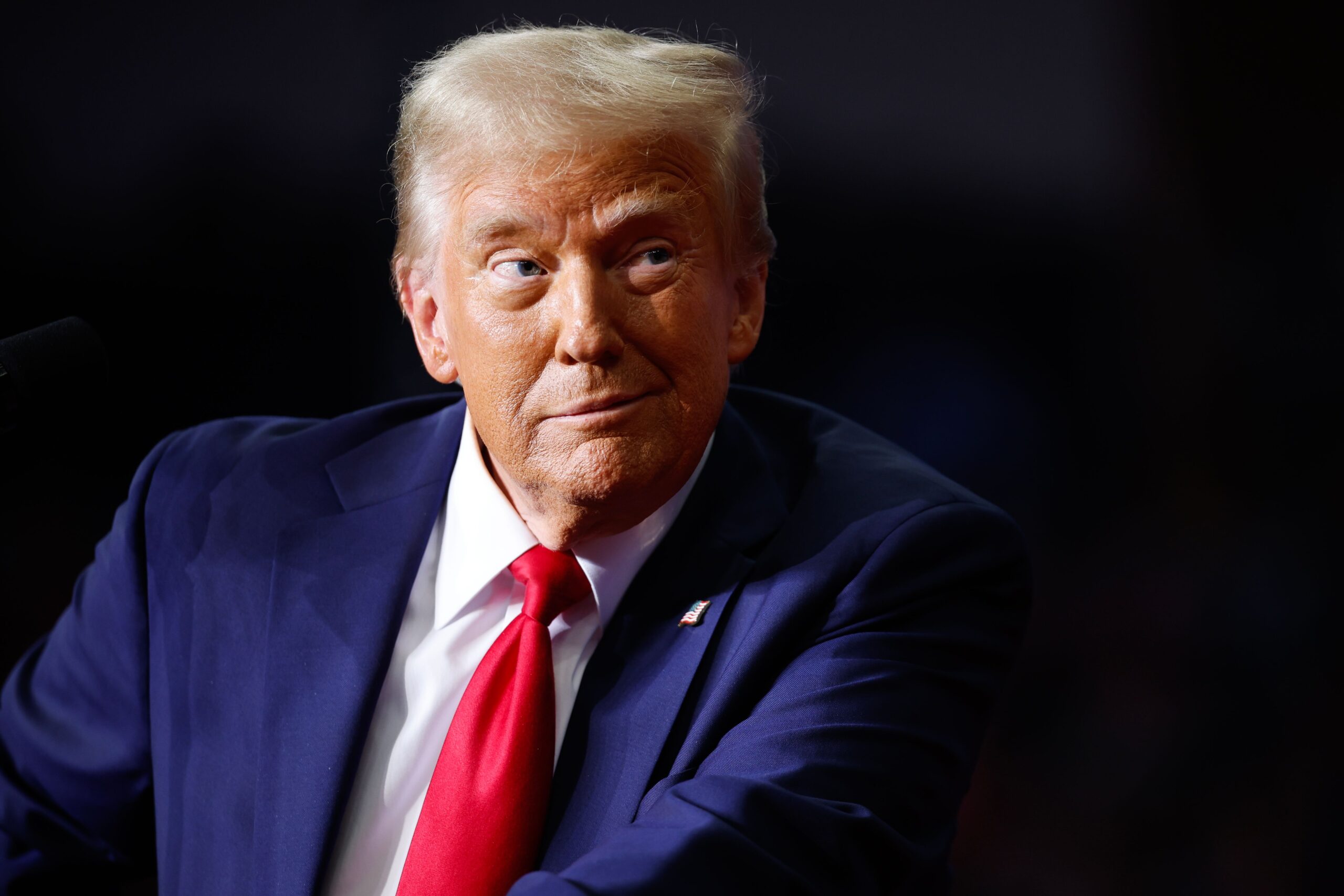Uncategorized
How a Sitting President Became a Crypto’s Most Sought-After Investor

Crypto isn’t all that different from politics. According to Rushi Manche, the founder of blockchain company Movement, «Crypto is an attention game.»
It’s fitting, then, that Donald Trump — the master of all things attention — is so at home selling memecoins. But it’s not just Trump’s inner circle that’s managed to capitalize on his crypto ventures, which include the $TRUMP coin and World Liberty Financial.
Once a vocal crypto skeptic, the president has become the industry’s largest «key opinion leader» — or KOL, in blockchain industry parlance: a trader whose portfolio is closely watched by other investors deciding what to buy and sell.
Trump’s foray into crypto has created a new go-to-market playbook for ambitious token peddlers like Manche — blockchain founders who realize pumping the price of a token can be as simple as elbowing into a sitting president’s crypto portfolio.
The president’s primary vehicle for blockchain trades is World Liberty Financial (WLFI), a decentralized finance (DeFi) venture he announced with his sons over the summer. After accruing more than $400 million by selling a token, the company, which does not yet have a product, has built up a portfolio containing millions of dollars in the assets of other crypto projects. On Wednesday, it announced it was launching an official «strategic reserve» of crypto investments.
The trades have already raised serious concerns about conflicts of interest, insider dealing, and the very nature of how influence is leveraged in the digital asset space. Trump’s political opponents are calling for investigations into his growing blockchain empire.
But crypto founders like Manche see World Liberty’s crypto investments as something different: a once-in-a-generation marketing opportunity. «You need to have a product roadmap that makes sense,» said Manche. «But you also need to have a strategy for your token.» And what better way to boost the price of your cryptocurrency than by publicly tying it to the leader of the free world?
Moving MOVE
Twenty-two-year-old Rushi Manche is set to launch Movement L2, an Ethereum-based blockchain. Despite his youth, he’s earned a reputation within the industry as a sharp operator, having secured over $38 million in venture funding immediately after college.
Ahead of Donald Trump’s second term, Manche worked to forge ties with his circle. On the eve of the inauguration, he attended the Crypto Ball, an event connecting crypto industry leaders with political insiders. There, he engaged with key figures like Zak Folkman and Chase Herro, leaders of Trump’s World Liberty Financial.
On Jan. 28, when news broke that World Liberty Financial had acquired approximately $2 million in the Movement’s MOVE tokens, Manche pounced.
Immediately, he took to social media: “We are proud to be the first altcoin, first modern blockchain platform, and first alternative [virtual machine] under the new administration,» he wrote in an X post. «MOVE is Made in America.»
Then, in media interviews throughout the day, he described the WLFI purchases as a positive sign for Movement’s trajectory: «It’s a good sign that the president of the United States’s DeFi program is purchasing MOVE,» he told CoinDesk. «It shows a good sign of faith, and good solidarity with Movement ecosystem.»
Rumors suddenly started swirling on X that Elon Musk was eyeing Movement as a potential infrastructure partner for his Department of Government Efficiency (DOGE).
Manche distanced himself from the rumor, claiming he had only heard about it when the rest of the public did. But he didn’t discourage the speculation, either. «We can’t really talk much about it,» he told CoinDesk. «Our papers have never hit the DOGE desk,» but «we work with a variety of government agencies and institutions.»
The MOVE price briefly surged by 20% within hours of the news.
The World Liberty Financial play
Manche is far from the only crypto founder to recognize the value of associating with the Trump blockchain brand.
Donald Trump announced World Liberty Financial in mid-October, during the final days of his presidential campaign. The company says it is building a crypto lending platform that advances American values, but it has yet to launch a product. Within days of its formal announcement, however, it began selling a token, WLFI.
Read more: Inside the Trump Crypto Project Linked to a $2M DeFi Hack and Former Pick-Up Artist
According to a disclaimer on the World Liberty website, Donald Trump holds a majority stake in the venture through his company, DT Marks LLC, and is entitled to around 75% of WLFI token sale proceeds. The token provides holders with a vote on the eventual platform’s direction. Currently, it is impossible to trade and has restricted sales to non-Americans and accredited U.S. investors only.
Due to these restrictions, WLFI struggled to meet its fundraising targets initially. What’s the point of buying a cryptocurrency that you can’t sell for a profit? Many in the industry—including some of the president’s own supporters—criticized the sale as a cash grab.
But Justin Sun, a Chinese-born crypto founder, was among the first to reveal how WLFI might still appeal to a very specific type of investor. On Nov. 27, he bought $30 million in the incoming president’s WLFI tokens, making him the project’s largest single investor. Sun then lobbed praise onto Trump and WLFI in a series of social media posts.
Today, Sun is perhaps best known for purchasing a banana taped to a wall for $6.2 million, but the U.S. Securities and Exchange Commission — a department now under the control of Donald Trump’s White House — previously charged him with fraud and market manipulation. The case is ongoing.
The president’s crypto company, meanwhile, has purchased millions of dollars in TRX — the native token of Sun’s TRON blockchain — and WBTC, a Bitcoin derivative with suspected ties to Sun. World Liberty also named Sun an official adviser.
Blockworks reported on Feb. 3 that World Liberty Financial was shopping around a deal: if a project buys at least $10 million worth of WLFI tokens (with a 10% fee), WLFI will buy an equivalent amount of the project’s native token. Movement Labs and Tron denied making such agreements.
World Liberty’s investments are expected to accelerate with the establishment of a strategic reserve, but a lawyer for World Liberty Financial, Alex Golubitsky, said he could not comment on whether WLFI’s investments count as an official Trump endorsement.
The Trump family, however, seems aware of its power to move markets. On Feb. 3, shortly after World Liberty Financial reallocated a large share of its tokens into ether (ETH), the native token of Ethereum, Eric Trump tweeted, «In my opinion, its a great time to add $ETH. You can thank me later.»
He quickly edited the tweet, removing the “You can thank me later” line.
The art of the pump
Over the past several months, Rushi Manche made a concerted effort to ingratiate himself in Trump-world. He attended the crypto ball, an industry event on the eve of the inauguration that mixed figures from the administration with crypto industry leaders. He has also made frequent trips to Washington, D.C. where he has lobbied on behalf of the crypto industry with people like Zak Folkman and Chase Herro — the leaders of World Liberty Financial.
On Feb. 10, when WLFI made a second round of MOVE purchases, Manche immediately ran back the same playbook he had used a week earlier.
Within minutes, reporters received a press release from Movement’s PR team: MOVE was now «one of the most significant holdings in Trump’s portfolio,» the release read, and Manche was «available to discuss what Trump’s investment means for the project, its role in advancing blockchain, and the broader implications for the crypto industry.»
Manche again took to social media, reposting a photo of himself and Donald Trump Jr. alongside a screenshot of World Liberty’s MOVE purchases. The photo was taken at an event for Ondo, another project in World Liberty’s crypto portfolio.
«[P]olitics is the most important [go-to-market] play for crypto companies today,» Manche said in a lengthy X post a few minutes later. «[M]y sense is that the next five years will be a space race for crypto hegemony — the teams that can lock in the relationships with federal agencies, institutional capital, and world leaders are the ones that survive.»
The post drew heated debate. Some viewed Manche’s government-centric posturing as a shrewd business move. Others condemned it as a betrayal of crypto’s anti-establishment ethos — a shortsighted attempt to exploit Trump’s fame to pump a token ahead of a major product launch.
Manche is unfazed by the backlash. He likens Movement Labs’ approach to that of Cardano and Ripple — projects that, despite heavy scrutiny, have maintained strong market positions due to their deep understanding of how to earn and keep attention.
«Sure, you have anons on Twitter calling them scams,» he said. «But look who’s winning.»
He pointed to Ripple’s “XRP Army,” whose fervor has kept the project relevant despite technical critics and regulatory scrutiny. Ripple’s XRP token has topped price charts for nearly a decade, Manche said, by building «the biggest cult in the world.»
Similarly, he praised Charles Hoskinson, the outspoken founder of Cardano, for having «mastered the art of attention» and getting Cardano’s ADA token into the hands of so many investors. Hoskinson has «contributed more to the space» than the very same Ethereum developers who dismiss Cardano as «a broken blockchain,» Manche said.
«If you ask a taxi driver what they’re buying, they’ll tell you XRP, ADA — not even ETH,» said Manche. «That’s what the real people are talking about outside of our little bubble.»
As for Movement, Manche’s strategy is clear: align with Trump and grab attention, for better or worse. In his words: «Love me, hate me, just don’t forget me.»
Uncategorized
Elon Musk vs. the regulators
Welcome back to TechCrunch Mobility, your hub for all things “future of transportation.”
Uncategorized
Nvidia’s AI empire: A look at its top startup investments
Over the last two years, Nvidia has used its ballooning fortunes to invest in over 100 AI startups. Here are the giant semiconductor’s largest investments.
Uncategorized
Dating app Cerca will show how Gen Z really dates at TechCrunch Disrupt 2025
Cerca is a dating app that sets users up with mutual friends.
-

 Business12 месяцев ago
Business12 месяцев ago3 Ways to make your business presentation more relatable
-

 Fashion12 месяцев ago
Fashion12 месяцев agoAccording to Dior Couture, this taboo fashion accessory is back
-

 Entertainment12 месяцев ago
Entertainment12 месяцев ago10 Artists who retired from music and made a comeback
-

 Entertainment12 месяцев ago
Entertainment12 месяцев ago\’Better Call Saul\’ has been renewed for a fourth season
-

 Entertainment12 месяцев ago
Entertainment12 месяцев agoNew Season 8 Walking Dead trailer flashes forward in time
-

 Business12 месяцев ago
Business12 месяцев ago15 Habits that could be hurting your business relationships
-

 Uncategorized4 месяца ago
Uncategorized4 месяца agoRobinhood Launches Micro Bitcoin, Solana and XRP Futures Contracts
-

 Entertainment12 месяцев ago
Entertainment12 месяцев agoMeet Superman\’s grandfather in new trailer for Krypton


